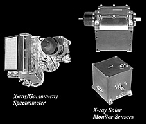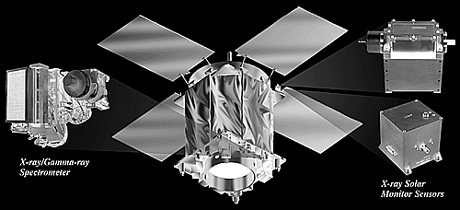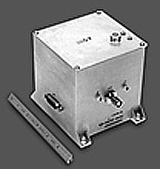 X-Ray/Gamma-Ray
Spectrometer
X-Ray/Gamma-Ray
Spectrometer
The X-ray/gamma-ray spectrometer (XGRS), one of five major facility
instruments on the NEAR spacecraft, is the primary experiment for
determining surface/near-surface elemental composition of the
near-Earth asteroid 433 Eros. XGRS measurements are fundamental to
solving such mysteries as the source of meteorites and their
relationship to asteroids.
XGRS, designed and built by The Johns Hopkins University Applied
Physics Laboratory, consists of two state-of-the-art sensors: an X-ray
fluorescence spectrometer and a gamma-ray spectrometer.
Spectroscopy
Redundant solar monitors are used to determine the incident solar
X-ray spectrum. X-rays from the Sun can produce significant count
rates of fluorescence X-rays from low-atomic-number surface elements
on Eros, such as Mg, Al, and Si. The elements S, Ca, Ti, and Fe are
also present in asteroids, but count rates are lower and data take
longer to accumulate.
Similarly, cosmic ray protons (and energetic particles associated with
solar flares) can interact with the asteroid surface and produce gamma
rays characteristic of the nuclear energy levels of a given element.
Gamma rays can also be spontaneously emitted by naturally occurring
radioactive elements such as K, U, and Th.
Remote X-ray and gamma-ray spectroscopy from spacecraft requires
bodies with little atmosphere so that the X-rays and gamma rays
returning to the spacecraft are not significantly absorbed. Orbital
rather than flyby missions are preferred for this type of measurement
because of the long observation time required.
Specifications
XGRS General
Mass: 26.90 kg
Power: 24 W (including DPU)
Development time: 19 months
X-Ray Fluorescence Spectrometer
Detectors: 3 gas-filled proportional counters; 25-cm2
active aperture area; 25-mm beryllium window, uniformity ~
±5%; Beryllium liner and window support
Energy range: 1 to 10 keV; Rise-time discrimination to reduce
background contamination
Energy resolution: <1 keV FWHM @ 5.95 keV
In-flight calibration sources: 55Fe
Counting rate: Full performance up to 10 kHz
X-Ray Solar Monitors
Gas-filled proportional counter with graded shield (resolution <1 keV
FWHM @5.95 keV) and solid-state high-resolution solar monitor
(resolution <600 eV FWHM @ 5.95 keV).
Gamma-Ray Spectrometer
Energy range: 0.3 to 10 MeV in 10-keV channels
Prime detector: 2.5 x 7.5 cm NaI (Tl) scintillator;
8.5% FWHM min resolution @ 662 keV FOV ~ 60°
Shield detector: 8.9 x 14 cm BGO scintillator cup shield; 15% FWHM min resolution @ 662 keV
Counting rate: Full performance up to 10 kHz
XGRS Instruments:

XGRS on
spacecraft

Proportional counter

Solar monitor
XGRS Objectives
A primary goal of the NEAR mission is to measure Eros' surface
composition accurately enough to establish the relationship between
asteroids and meteorites. Although meteorites are thought to originate
in the asteroid belt, the main type of meteorite (the ordinary
chondrite) does not have a clear analogue among the recognized classes
of Main Belt asteroids.
The XGRS detectors have been sized to differentiate among important
meteorite types. For example, the ordinary chondrite type H, the
carbonaceous chondrite CI, the basaltic achondrite eucrite, and the
stony-iron pallasite can all be distinguished from each other.
XGRS will either identify the type of meteorite to which Eros is
linked or confirm that there is no relationship. The average
composition of the asteroid will be determined to establish important
constraints on origin, history, and processing of asteroidal material.
Abundance maps of Mg, Al, Si, and Ca will be produced to determine
heterogeneities in the surface (regolith). To the extent that X-rays
and gamma rays can be compared for the same element, important
insights into regolith variation with depth can also be gained: X-rays
are emitted from the surface (less than a millimeter) while gamma rays
tend to probe deeper material, up to about 10 cm in depth.
XGRS Description
The X-ray fluorescence experiment uses three gas-filled proportional
counters, collimated to 5¡, observing X-ray line emissions from the
asteroid. Balanced filters on two detectors (Al on one and Mg on the
other) are used to separate Mg, Al, and Si lines; Ca, Ti, and Fe lines
are resolved. The solar monitor uses an additional gas-filled
proportional counter with a pinhole active area observing the X-ray
spectrum of the Sun. A high-resolution, solid-state solar monitor can
be alternatively selected. The gas-filled proportional counters were
designed and built by Metorex International Oy. The solid-state X-ray
detector was supplied by AMPTEK.
The gamma-ray spectrometer uses a body-mounted NaI scintillator with
BGO shield. This unique design eliminates the need for both a long
boom and active cooling. This subsystem of the XGRS detects naturally
radioactive elements-K, Th, U-by their gamma rays and those of their
decay chain products. In addition, it detects other elements-Fe, Si,
O, H-by gamma rays produced by cosmic ray interactions. The gamma rays
of interest are typically between 0.2 and 10 MeV. The detector
crystal/photomultiplier tube assembly was designed and built by EMR
Photoelectric, a division of Schlumberger.
XGRS Management
- Science Team:
- Jacob I. Trombka (NASA/GSFC), Leader
William V. Boynton (Univ. of Ariz.)
Johannes Brückner (Max-Planck Institut-Mainz)
Steven W. Squyres (Cornell Univ.)
- Lead Engineer:
- Lawrence J. Zanetti (JHU/APL)
- Lead Engineer:
- John O. Goldsten (JHU/APL)
- XGRS Instrument Scientist:
- Ralph L. McNutt, Jr. (JHU/APL)
- NEAR Payload Manager:
- Robert E. Gold (JHU/APL)
Links to the other NEAR instruments:
Return to Top of this page
Go to NEAR Overview Page
Go to Small Bodies Page
 Return to MSSS
Home Page
Return to MSSS
Home Page